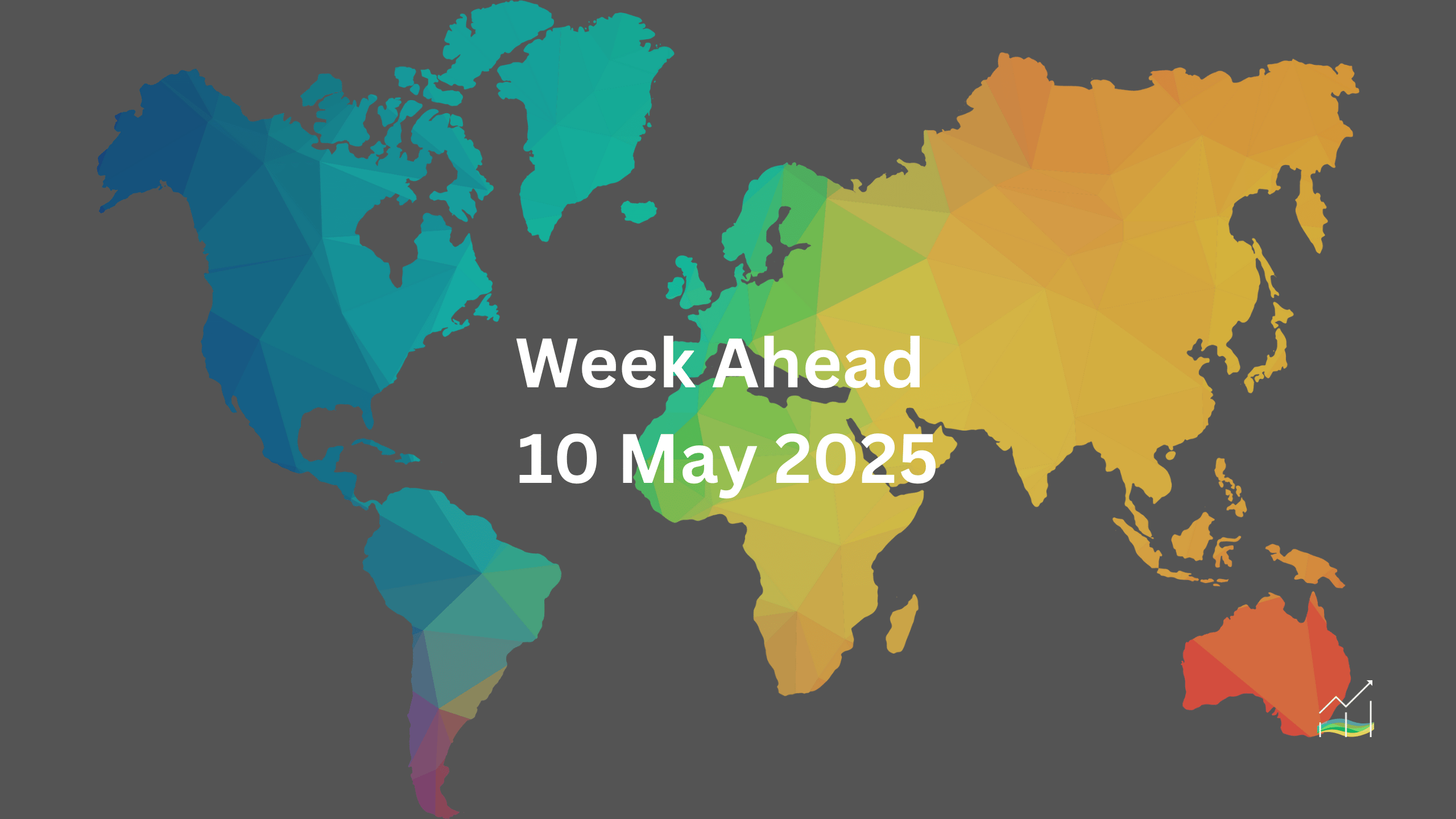10/05/2025 Week Ahead

Fragile Talks, Rising Risks: A Week Marked by Stalemates
Key Takeaways:
- US-China trade talks ended abruptly, with no clear resolution or explanation.
- Even partial tariff reductions would leave a de facto embargo in place.
- Rising nationalism in China may harden its geopolitical stance rather than lead to reforms.
- The US dollar strengthened modestly but remained in consolidation.
- Major central banks are expected to ease before the Federal Reserve.
- Key data ahead: US inflation, Japan and UK GDP, UK and Australian employment, and a 50 bp rate cut from Mexico.
- India and Pakistan appear to be pausing active conflict despite ongoing military mobilization.
Despite market hopes, the recent US-China trade discussions ended without progress. While there was optimism that the weekend meeting could ease tensions, early reports suggest the Chinese delegation exited without offering a clear reason, reinforcing doubts over the direction of these negotiations. Even if both sides were to reduce tariffs by half, a functional trade embargo would remain intact. Beyond trade, the broader US approach — including efforts to block Chinese exports and investment strategies — is more likely to provoke heightened nationalism in Beijing than prompt meaningful reforms. History reminds us that punitive economic pressure often breeds defiance rather than compliance.
Meanwhile, the US dollar posted modest gains across most G10 currencies but failed to sustain momentum, remaining stuck within a broad consolidation range. The Federal Reserve acknowledged heightened risks to its dual mandate, reiterating that there is no immediate pressure to adjust policy amid growing global uncertainty — much of it rooted in US actions. In contrast, several other major central banks, including those in Europe, the UK, and Canada, are expected to move ahead with rate cuts before the Fed.
Looking ahead, key events will help shape market expectations. The US will release its latest CPI data, likely showing little change. Japan and the UK are set to publish initial Q1 GDP estimates, while both the UK and Australia will report on employment. Mexico’s central bank is also anticipated to cut rates by 50 basis points. On the geopolitical front, tentative calm appears to be holding between India and Pakistan, even as both continue military posturing.
United States of America
Overview
The US dollar has entered a corrective phase after weakening steadily from mid-January to early May. While it has regained ground recently, the gains appear fragile and technical in nature, rather than driven by renewed economic strength. The resilience of the US labour market has kept the Federal Reserve from rushing into rate cuts, placing it behind most other G10 central banks in the easing cycle — with the exception of Japan. However, a range of looming headwinds casts a shadow over the outlook.
Key risks include a supply shock stemming from punitive tariffs on Chinese goods, reduced foreign tourist bookings, mounting consumer pessimism, and a pullback in demand from sectors tied to student loans, immigration, and government employment. While these pressures are real, they may not be fully reflected in the data until July or August. For now, markets will be watching closely as CPI and retail sales figures are released alongside a series of scheduled appearances by Fed officials.
Economic Drivers
- Continued strength in the labour market limits the Fed's near-term incentive to cut rates.
- Other G10 central banks are expected to ease policy before the Fed, supporting relative dollar strength.
- Tariffs on Chinese goods may trigger a new supply shock.
- Economic sentiment is weakening due to reduced tourism, boycotts of US brands abroad, and domestic pressures such as student loan repayments and public sector layoffs.
- Consumer confidence is falling rapidly, suggesting further slowdown ahead.
Data and Events
- May 13, 2025: US CPI YoY (April) – expected around 2.4%.
- May 15, 2025: US Retail Sales – projected to be firm, partly due to tariff-avoidance behaviour.
- May 15, 2025: US Industrial Production – expected rebound following March’s -0.3% print.
- May 16, 2025: US Housing Starts – expected recovery from March’s sharp 11.4% drop.
- May 15–17, 2025: Multiple Fed officials scheduled to speak ahead of Powell’s address.
Price Action
- Dollar Index closed above 100.00 for a second week, rising for the third consecutive week.
- Momentum indicators are improving, pointing to a continued corrective phase.
- A move above 101.30–40 could extend the rally toward 102.00–20.
- A break below 99.15 would negate the bullish tone and suggest renewed weakness.
Key Points:
- The US dollar has entered a short-term corrective phase.
- Strong labour data keeps the Fed on hold while others prepare to ease.
- Mounting economic risks may take months to appear in hard data.
- CPI, retail sales, and housing starts will be closely watched this week.
- Dollar Index momentum is improving but fragile above 100.00.
Australia
Overview
The Australian dollar experienced a volatile week, initially benefiting from a weaker US dollar and speculation that the US-China trade conflict had peaked. Optimism was based on hopes that recent developments amounted to an informal embargo, leading to expectations of a potential de-escalation. However, the Aussie’s brief push above 0.6500 was quickly rejected, triggering a wave of caution among short-term traders.
Fundamentally, sentiment has been supported by inflation expectations and a positive consumer outlook. The latest consumer inflation survey from the Melbourne Institute indicated rising price expectations, with the reading reaching its highest level since September of last year. However, the broader economic picture remains subdued. Employment data for Q1 revealed a stagnation in job growth, with full-time positions rising at their slowest pace in over a year. Meanwhile, yields have dropped sharply in recent weeks, resulting in a steepening of the yield curve — typically seen as a bullish signal but also reflecting increased expectations for rate cuts.
Economic Drivers
- Australian dollar briefly supported by weakness in the US dollar and speculation of a US-China trade truce.
- Melbourne Institute’s consumer survey showed inflation expectations at 4.2% in March, the highest in 2025 so far.
- Overall job growth nearly stalled in Q1 2025, showing the weakest performance since Q3 2021.
- Full-time employment rose by only 9k in Q1, down significantly from prior quarters.
- A steepening of the yield curve suggests rising expectations for further policy easing.
Data and Events
- May 15, 2025: Consumer Inflation Expectations (May) – most recent reading at 4.2%.
- May 15, 2025: Employment Report (April) – final high-frequency data ahead of next central bank meeting.
Price Action
- Aussie briefly rose to 0.6515 but faced a strong reversal, falling to nearly 0.6370.
- Recovered to 0.6435 in late trading, boosted by hopes of US-China trade de-escalation.
- Initial resistance lies around 0.6440–0.6460.
- Failure of trade talks could see the currency retest support between 0.6350 and 0.6370.
Key Points:
- AUD volatility driven by shifting sentiment on US-China relations.
- Inflation expectations rose to 2025 highs, but job growth remains weak.
- Market now awaits April’s employment data and May’s inflation survey.
- Yield curve steepening reflects expectations of policy easing.
- AUD failed to hold above 0.6500, with key support seen around 0.6350.
Canada
Overview
The Canadian dollar remains largely driven by the broader direction of the US dollar, with correlations at their highest levels in six months. While the loonie sometimes behaves as a risk-sensitive currency, that relationship has faded for now. Instead, the Canadian dollar is moving in tandem with the Dollar Index, showing reduced sensitivity to equity markets such as the S&P 500.
Recent data has done little to support the currency. The unemployment rate rose to 6.9% in April, accompanied by a significant loss of 31,000 manufacturing jobs — the largest decline outside the pandemic period since January 2009. This labour market weakness comes at a time when capital flows are also turning. Canada averaged healthy monthly net inflows of C$16 billion in 2024, but early 2025 has seen a sharp reversal, with the slowest start to the year for portfolio investment since 2004.
With the CPI report scheduled for later in the month, this week’s focus will be on housing data, including housing starts, permits, and existing home sales. Inflows data due at the end of the week will also be closely watched for signs of whether capital flight is intensifying or stabilising.
Economic Drivers
- CAD trading closely reflects broader US dollar movements, not risk sentiment.
- Labour market softening, with a notable jump in unemployment and significant job losses in manufacturing.
- Capital inflows have slowed sharply in early 2025, raising concerns over investor confidence.
- Historical correlation with equity markets has weakened considerably.
Data and Events
- May 14, 2025: Housing Starts and Building Permits (April).
- May 15, 2025: Existing Home Sales (April).
- May 16, 2025: Portfolio Investment in Canadian Securities (March).
Price Action
- Canadian dollar was the only G10 currency not to rise against the US dollar last week.
- USD/CAD held above 1.3900, supported by weak Canadian data.
- Momentum remains in favour of USD strength; 1.4000–1.4030 is a near-term upside target.
- Support seen around 1.3850–1.3870.
Key Points:
- CAD strength continues to mirror broader US dollar trends.
- Labour data shows economic softening, especially in manufacturing.
- Portfolio flows are at their weakest start since 2004.
- Housing data and capital flows in focus this week.
- USD/CAD remains technically supported above 1.3900.
China
Overview
Chinese authorities appear willing to tolerate a partial pullback in the yuan’s recent strength against the dollar, reflecting a broader recalibration as the trade environment worsens. The US has effectively imposed an economic embargo on Chinese goods, creating structural challenges for China's export-driven economy. In response, Beijing has selectively relaxed some tariffs on US imports, not as a sign of concession but rather to mitigate domestic fallout.
With foreign demand weakening, especially from the US, the pressure on Beijing to stimulate domestic consumption is intensifying. Without sufficient internal demand to absorb the excess capacity, China risks straining its relationships with other major trading partners if it redirects its export focus. This balancing act is increasingly delicate, especially as data continues to show entrenched deflationary trends and sluggish investment inflows.
April’s inflation data showed little sign of price pressure. Consumer prices declined 0.1% year-over-year, in line with expectations, with continued weakness in both consumer goods and food prices. Producer prices also saw the steepest decline in six months, falling 2.7% from a year earlier. Meanwhile, lending data shows aggressive credit expansion, while foreign direct investment remains soft — consistent with ongoing global de-risking from China exposure.
Economic Drivers
- Chinese officials appear open to a mild yuan depreciation to counter weakening trade momentum.
- US tariffs remain a major drag, acting as a de facto embargo on Chinese goods.
- China is selectively easing tariffs on US goods to limit domestic economic damage, not to signal retreat.
- Lack of strong domestic stimulus increases risk of over-exporting to alternative markets, which could strain global trade ties.
- Persistent deflation in both consumer and producer prices points to entrenched demand weakness.
- FDI remains historically low, with no year-over-year increase since May 2023.
Data and Events
- May 19, 2025: Foreign Direct Investment (April) – expected to remain weak.
Price Action
- USD/CNH peaked near 7.2530 before pulling back to 7.2340.
- Initial support lies between 7.2225 and 7.2250.
- A break above 7.2600 could lead to a test of the 7.3000 level.
Key Points:
- China’s economy faces structural pressure from US trade restrictions.
- Consumer and producer prices remain in deflation territory.
- April lending shows strong credit expansion, but FDI remains weak.
- Authorities cautiously manage yuan strength amid external weakness.
- USD/CNH remains range-bound with key support near 7.2225.
Europe
Overview
After a strong rally that lasted from early February through late April, the euro’s momentum has faded. The market now faces a key inflection point: whether the single currency will enter a period of broad consolidation or begin a more pronounced correction. Fundamentally, the euro remains vulnerable to a more hawkish Federal Reserve stance, especially as the European Central Bank is widely expected to cut interest rates before the Fed resumes easing.
The underlying divergence in transatlantic economic conditions adds to the euro’s challenges. While the US economy contracted by 0.3% in the first quarter, the eurozone posted a stronger-than-expected annualised growth rate of 1.6%. However, this pace is unlikely to be sustained, with forecasts pointing to a significant slowdown in Q2. In Germany, business sentiment remains weak despite signs of marginal improvement. The latest ZEW survey showed a sharp drop in forward-looking expectations, highlighting persistent uncertainty in the euro area’s largest economy.
Economic Drivers
- ECB is expected to cut interest rates before the Federal Reserve, given relative economic and labour market conditions.
- The US-Germany two-year yield spread has widened by roughly 20 basis points since late April, supporting the dollar.
- Eurozone outperformed the US in Q1 growth, but momentum is projected to slow significantly in Q2.
- Germany's ZEW expectations index saw a sharp drop in April, reflecting deteriorating business sentiment.
Data and Events
- May 13, 2025: German ZEW Economic Sentiment (May).
- May 15, 2025: Eurozone GDP Second Estimate (Q1 2025).
Price Action
- Euro found support just below $1.12, marking a four-week low.
- Five-day moving average fell below the 20-day moving average, signalling potential trend shift.
- Key Fibonacci support levels at $1.1150 and $1.1050.
- A move above $1.1300 would favour consolidation over a deeper correction.
Key Points:
- Euro rally has paused; markets are reassessing direction.
- ECB is expected to ease ahead of the Fed amid slowing eurozone growth.
- German sentiment data signals renewed concern.
- Euro technical levels suggest risk of near-term correction unless $1.1300 is cleared.
Japan
Overview
The Japanese yen has increasingly decoupled from US Treasury yields and is now trading more in line with overall US dollar movements and global equity sentiment. The currency's correlation with the Dollar Index is at its highest level since 2016, while its link to the US 10-year yield has fallen to multi-month lows. This shift suggests that the yen is behaving more like a broad risk-sensitive currency, particularly in relation to US dollar strength and equity market dynamics.
On the macro front, Japan is preparing to release its Q1 2025 GDP report, which is expected to show a sharp deceleration from the previous quarter. The economy expanded at a 2.2% annualised rate in Q4 2024, but growth is now forecast to slow to just 0.2%. Weakness is likely to stem from a decline in net exports, as well as slower investment and government consumption. Industrial output has been stagnant, offering little support. Additional attention will be given to the March current account data and accompanying breakdowns of Japan’s foreign bond and equity transactions, especially in light of reports of heavy foreign bond selling earlier in April.
Economic Drivers
- Yen movements are now strongly aligned with the broader US dollar trend, with the highest correlation since 2016.
- Correlation with US 10-year yields has collapsed, weakening the traditional yield-based influence on the yen.
- The yen is trading more like a risk currency, with rising correlation to equity markets.
- Q1 GDP growth expected to decelerate sharply due to slower exports, investment, and consumption.
- Industrial production remains stagnant, reflecting weak domestic momentum.
- Mixed capital flows in April, with large bond sales early in the month and moderate equity purchases throughout.
Data and Events
- May 13, 2025: Current Account (March).
- May 16, 2025: GDP First Estimate (Q1 2025) – forecast 0.2% annualised growth.
Price Action
- USD/JPY reached a four-week high near 146.20 but reversed sharply to 144.80 late in the week.
- The 146.00 area has capped upside for two consecutive weeks.
- Downtrend line from January and March highs acts as resistance, starting near 146.90 and ending the week around 146.35.
- Failure to clear 146.90 may keep USD/JPY in a sideways range for now.
Key Points:
- Yen increasingly moves in sync with the broader US dollar and equity sentiment.
- Yield correlations have weakened; risk dynamics are more influential.
- Japan’s Q1 growth is expected to slow to near stagnation.
- Mixed capital flows reflect cautious investor sentiment.
- USD/JPY resistance holds around 146.00–146.90.
United Kingdom
Overview
The British pound continues to closely track movements in the euro, reflecting strong alignment between the two currencies against the US dollar. Correlations remain high, with 30-day and 60-day measures both well above 0.75 — levels that have held consistently throughout the year. Despite last week’s rate cut and accompanying commentary, markets now expect a slower pace of policy easing, with the implied year-end rate rising to around 3.65% from the current 4.25%.
While a new trade deal with the US appears to carry limited economic weight, it has broader geopolitical implications. It signals a further shift away from the European Union and may complicate future trade negotiations with other partners, particularly those concerned about the UK’s position on reciprocal tariffs. These structural shifts may not have immediate market effects but reinforce the UK’s evolving trade identity.
Attention this week will turn to high-frequency data including employment, Q1 GDP, and March activity indicators. Economic growth is expected to come in at 0.3% for the first quarter, recovering modestly from the stagnation seen in the second half of 2024. However, this falls short of the Bank of England’s more optimistic forecast of 0.6%. Underlying indicators such as consumption and manufacturing remain weak, limiting any near-term recovery momentum.
Economic Drivers
- Sterling remains strongly correlated with euro movements against the dollar, with high sustained correlation levels.
- Market pricing reflects a slower pace of BOE easing following recent rate cut and commentary.
- The US-UK trade agreement has minimal economic impact but carries geopolitical significance.
- UK trade posture is increasingly diverging from the EU, complicating future negotiations.
- BOE’s growth forecast for Q1 appears optimistic compared to private estimates and data trends.
Data and Events
- May 13, 2025: Unemployment Report (March).
- May 15, 2025: GDP First Estimate (Q1 2025).
- May 15, 2025: Monthly Real Sector Activity Data (March) – including manufacturing and consumption.
Price Action
- GBP/USD dipped near 1.3200 before rebounding to 1.3325 late in the week.
- Momentum indicators continue to weaken, with short-term averages signalling potential loss of upward momentum.
- Price action suggests consolidation rather than a full-scale correction.
- Resistance capped around 1.3400–1.3440; no new highs were posted last week.
Key Points:
- Sterling remains highly correlated with euro performance.
- BOE is expected to ease gradually; rate expectations have shifted upward.
- Q1 GDP is forecast at 0.3%, below BOE’s 0.6% projection.
- US-UK trade deal has limited economic impact but shifts UK further from EU.
- Sterling consolidating below key resistance near 1.3400.
© 2025 SKONE Enterprise (003319453-V). All rights reserved.
The content on this site is for informational purposes only and does not constitute financial advice.


